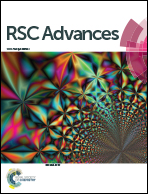Synthesis of ternary oxide Zn2GeO4 nanowire networks and their deep ultraviolet detection properties
Abstract
Ternary oxide Zn2GeO4 with a wide bandgap of 4.84 eV, as a candidate for fourth generation semiconductors, has attracted a great deal of attention for deep ultraviolet (DUV) photodetector applications, because it is expected to be blind to the UV-A/B band (290–400 nm) and only responsive to the UV-C band (200–290 nm). Here, we report on the synthesis of Zn2GeO4 nanowire (NW) networks by lower pressure chemical vapor deposition and investigate their corresponding DUV detection properties. We find that pure Zn2GeO4 NWs could be obtained at a growth pressure of 1 kPa. The DUV detection tests reveal that growth pressure exerts a significant effect on DUV detection performance. The Zn2GeO4 NW networks produced under 1 kPa show an excellent solar-blind photoresponsivity with fast rise and decay times (trise ≈ 0.17 s and tdecay ≈ 0.14 s).



 Please wait while we load your content...
Please wait while we load your content...